You are here
New Releases

The rights and wellbeing of older persons in the State of Palestine

UNFPA Palestine Situation Report #5
15th January marked the 100th day of continuous war in Gaza and the crisis intensifies each day. Of Gaza’s 2.2 million people, more than 1.7 million have been displaced, including many who have been forcibly displaced multiple times. According to MoH Gaza, as of 23 January, there have been 25,490 deaths, and 63,354 injuries in addition to the thousands of persons who remain missing. 70% of deaths are women and children.
With hospitals overwhelmed by casualties and lacking essential fuel, medicines and basic supplies, many people will be cut off from safe delivery services. Furthermore, UNFPA and humanitarian actors have been denied humanitarian access to deliver pharmaceuticals, supplies, medical equipment and to deliver services particularly in the north. OCHA indicated that only 7/29 planned missions north of Wadi Gaza reached their destination in the first weeks of January while the other 22 were denied access by the Israeli authorities.
According to the World Health Organization, as of 15 January, only 15 out of Gaza’s 36 hospitals are even partially functional – nine in the south and six in the north. Among the estimated 180 women give birth each day in Gaza, 15% are expected to experience pregnancy- or birth-related complications. Limited access to appropriate services and denied delivery of humanitarian supplies will directly impact the 840 pregnant women expected to experience an obstetric complication in the next month which can increase rates of maternal and newborn morbidity and mortality.
UNFPA has scaled up its presence through deployments of the UNFPA Representative, GBV and SRH technical specialists and a security advisor who joined the UNFPA national staff in Gaza. On 5th January, UNFPA and WHO conducted a high-risk mission to Nasser Hospital and the UNRWA field hospital, delivering much-needed reproductive health (RH) supplies to ensure safe births.
"Midwives at Nasser Hospital told us that they are tired, they themselves cannot see their own families. The head of hospital said he visits his wife and children for two hours once a week. They are exhausted and demand a ceasefire. The midwives told us that they are currently handling 25 deliveries and 8 c-sections daily, way above their normal capacities. UNFPA will continue to be on the ground to deliver needed supplies and provide our solidarity and support for the heroic midwives and doctors ensuring safe births in Gaza." Dominic Allen, UNFPA Representative, during his mission in Gaza.
According to the Integrated Food Security Phase Classification (IPC) report, the entire population faces risk of famine and are classified in IPC phase 3 or higher. This is the highest share of people facing high levels of acute food insecurity ever classified for any given area or country. An estimated 335,000 children and 155,000 pregnant and lactating women are among the highest at risk of severe malnutrition and preventable death.
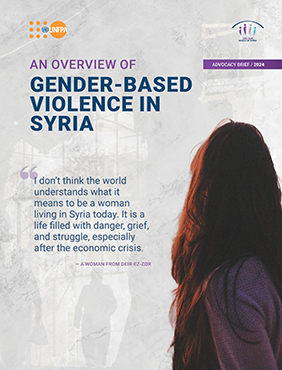
An Overview of Gender-Based Violence in Syria (2024)
Thirteen years since its onset, the Syria crisis remains one of the world’s worst and longest humanitarian situations. In 2023, Syrians faced one of the worst years of this crisis, marked by a multitude of converging challenges that included ongoing hostilities, economic collapse, health outbreaks, natural disasters, climate-related challenges, mass displacement, food insecurity, and others. Coping capacities of households reportedly reached an all-time low and, despite increasing needs, there was a drastic reduction in humanitarian assistance due to funding shortfalls.
As in previous years, women and girls were the worst off, suffering heightened risks of negative coping mechanisms and gender-based violence (GBV). Most women and girls experienced compounded forms of violence, while facing high barriers to access humanitarian assistance and specialised GBV services.
This advocacy brief provides a snapshot of gender-based violence in Syria as the country prepares for yet another difficult year. The brief offers a closer look at affected populations, the types of gender-based violence taking place, and the risks of GBV in other sectors, in addition to a series of recommendations for donors, humanitarians, and GBV actors.
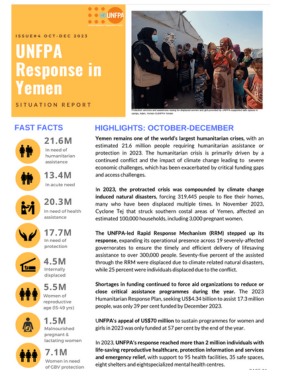
UNFPA Response in Yemen Situation Report #4 – October-December 2023
Yemen remains one of the world’s largest humanitarian crises, with an estimated 21.6 million people requiring humanitarian assistance or protection in 2023. The prolonged crisis was exacerbated by climate change-induced disasters, displacing over 300,000 people, many experiencing repeated displacement. UNFPA's Rapid Response Mechanism (RRM) expanded its operations across 19 severely affected governorates.
UNFPA's 2023 response reached over 2 million individuals, providing critical reproductive healthcare, protection services, and emergency relief. This included support to 95 health facilities, 35 safe spaces, eight shelters, and eight specialized mental health centres.
UNFPA's appeal for $70 million to sustain programmes for women and girls in 2023 was only 57 percent funded by year-end.

Regional Situation Report on the Syria Crisis - November 2023
As of November 2023, the needs of Syrians and host communities are higher than ever, particularly in light of widespread economic collapse, the cumulative impact of 12 years of conflict, climate-related challenges, natural disasters, and various other socio-political factors.
Despite the continuing efforts of humanitarian actors, the Syria crisis remains one of the world’s most complex humanitarian and protection emergencies. In 2023, 15.3 million people are in need of humanitarian assistance — the highest number since the onset of the crisis in 2011. This includes 7.7 million women and girls, around 4 million of whom are of reproductive age. Meanwhile, more than 6.8 million Syrian refugees remain as refugees in five neighbouring countries – Türkiye, Lebanon, Jordan, Iraq and Egypt, nearly half of whom are women and girls.
This report offers a bird’s eye view of UNFPA’s operations within the context of the Syria crisis. The report is prepared by the UNFPA Regional Humanitarian Hub for Syria and the Arab States (The Hub) in Amman, and spans operations led by UNFPA offices in Türkiye, Lebanon, Jordan, Iraq, and Egypt, in addition to operations led inside Syria, both from Damascus and cross-border via Türkiye.
The quantitative data presented in this report is cumulative, covering achievements made between January 2023 and the reporting month.

Overview of Funding Needs / UNFPA Regional Syria Crisis Response
In 2024, UNFPA is appealing for a total of $132.5 million to fund its regional Syria crisis response, of which only 21 percent has been funded. This document provides an overview of the needs across the crisis region, which covers the Whole of Syria, Türkiye, Lebanon, Jordan, Iraq, and Egypt.
Despite the continuing efforts of humanitarian actors, the Syria crisis remains one of the world’s most complex humanitarian and protection emergencies. In 2024, 16.7 million people are in need of humanitarian assistance — the highest number since the onset of the crisis in 2011. This includes 8.4 million women and girls, around 4.2 million of whom are of reproductive age. Meanwhile, more than 6.3 million Syrian refugees remain in five neighbouring countries, nearly half of whom are women and girls who face mounting risks of violence, exploitation, and lack of access to essential services.
For millions of Syrians / host communities, there are no alternatives to UNFPA-supported services. Underfunding UNFPA-supported programmes deprives entire communities of life-saving SRH services, which translates to more mothers and their infants dying or facing the life-long consequences of obstetric and newborn complications. It also leads to the closure of Safe Spaces and health facilities, which provide life-saving care, protection, and pathways to brighter futures for hundreds of thousands of women and girls every year.
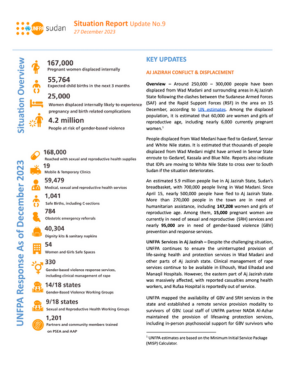
UNFPA Sudan Emergency Situation Report No.9 - 27 December 2023
Around 250,000 – 300,000 people have been displaced from Wad Madani and surrounding areas in Aj Jazirah State following the clashes between the Sudanese Armed Forces (SAF) and the Rapid Support Forces (RSF) in the area on 15 December, according to UN estimates. Among the displaced population, it is estimated that 60,000 are women and girls of reproductive age, including nearly 6,000 currently pregnant women.
People displaced from Wad Medani have fled to Gedaref, Sennar and White Nile states. It is estimated that thousands of people displaced from Wad Medani might have arrived in Sennar State enroute to Gedaref, Kassala and Blue Nile. Reports also indicate that IDPs are moving to White Nile State to cross over to South Sudan if the situation deteriorates.
An estimated 5.9 million people live in Aj Jazirah State, Sudan’s breadbasket, with 700,000 people living in Wad Madani. Since April 15, nearly 500,000 people have fled to Aj Jazirah State.
More than 270,000 people in the town are in need of humanitarian assistance, including 147,208 women and girls of reproductive age. Among them, 15,000 pregnant women are currently in need of sexual and reproductive (SRH) services and nearly 95,000 are in need of gender-based violence (GBV) prevention and response services.
UNFPA Services in Aj Jazirah – Despite the challenging situation, UNFPA continues to ensure the uninterrupted provision of life-saving health and protection services in Wad Madani and other parts of Aj Jazirah state. Clinical management of rape services continue to be available in Elhoush, Wad Elhadad and Manaqil Hospitals. However, the eastern part of Aj Jazirah state was massively affected, with reported casualties among health workers, and Rufaa Hospital is reportedly out of service.
UNFPA mapped the availability of GBV and SRH services in the state and established a remote service provision modality to survivors of GBV. Local staff of UNFPA partner NADA Al-Azhar maintained the provision of lifesaving protection services, including in-person psychosocial support for GBV survivors who reported to UNFPA-supported facilities in Hasahisa, as well as remote support to survivors who could not access the facilities.
Additionally, UNFPA continued to provide remote technical support to GBV case managers and social workers managing GBV cases, including guidance on remote service delivery, dealing with child and male survivors, as well as self-care.
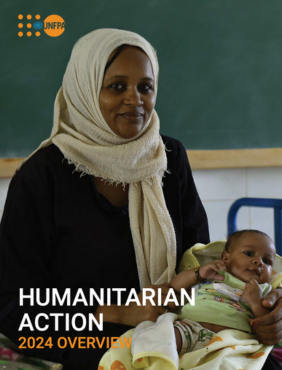
Humanitarian Action Overview Report 2024
In 2023, conflicts and natural disasters devastated the lives of millions of people around the globe. Even as bombs fell and the earth shook and climate impacts continued to be felt, women and girls in humanitarian contexts continued to give birth, to require sexual and reproductive health services, and to seek safety from gender-based violence in their homes and communities. Throughout, UNFPA stood by their side, providing essential services, protecting dignity and rights, and restoring hope. We saved lives and supported a path to a brighter future for women and girls. Najwa, in Aleppo, described struggling through multiple, overlapping catastrophes: “My suffering started with the war in Syria, then the economic situation got worse, and the last straw was the earthquake.” Things began to turn around for Najwa once she was able to receive critical services at a UNFPA safe space
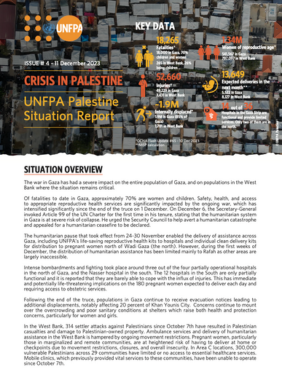
UNFPA Palestine Situation Report #4 - 11 December 2023
ank where the situation remains critical.
Of fatalities to date in Gaza, approximately 70% are women and children. Safety, health, and access to appropriate reproductive health services are significantly impacted by the ongoing war, which has intensified significantly since the end of the truce on 1 December. On December 6, the Secretary-General invoked Article 99 of the UN Charter for the first time in his tenure, stating that the humanitarian system in Gaza is at severe risk of collapse. He urged the Security Council to help avert a humanitarian catastrophe and appealed for a humanitarian ceasefire to be declared.
The humanitarian pause that took effect from 24-30 November enabled the delivery of assistance across Gaza, including UNFPA’s life-saving reproductive health kits to hospitals and individual clean delivery kits for distribution to pregnant women north of Wadi Gaza (the north). However, during the first weeks of December, the distribution of humanitarian assistance has been limited mainly to Rafah as other areas are largely inaccessible.
Intense bombardments and fighting took place around three out of the four partially operational hospitals in the north of Gaza, and the Nasser hospital in the south. The 12 hospitals in the South are only partially functional and it is reported that they are barely able to cope with the influx of injuries. This has immediate and potentially life-threatening implications on the 180 pregnant women expected to deliver each day and requiring access to obstetric services.
Following the end of the truce, populations in Gaza continue to receive evacuation notices leading to additional displacements, notably affecting 20 percent of Khan Younis City. Concerns continue to mount over the overcrowding and poor sanitary conditions at shelters which raise both health and protection concerns, particularly for women and girls.
In the West Bank, 314 settler attacks against Palestinians since October 7th have resulted in Palestinian casualties and damage to Palestinian-owned property. Ambulance services and delivery of humanitarian assistance in the West Bank is hampered by ongoing movement restrictions. Pregnant women, particularly those in marginalized and remote communities, are at heightened risk of having to deliver at home or checkpoints due to movement restrictions, closures, and overall insecurity. In Area C locations, 300,000 vulnerable Palestinians across 29 communities have limited or no access to essential healthcare services. Mobile clinics, which previously provided vital services to these communities, have been unable to operate since October 7th.
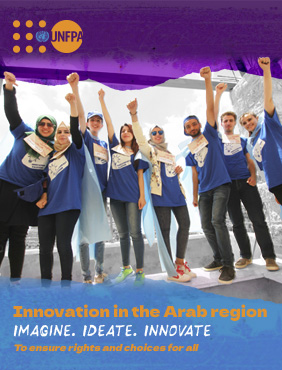
Innovation in the Arab region
Innovation is key to unlocking an Arab world of opportunity. Recognizing the power and potential of innovation to accelerate progress towards UNFPA’s three Transformative Results, UNFPA in the Arab states advances groundbreaking initiatives and solutions powered by technology to reach women, girls and youth everywhere including in humanitarian and conflict settings. This innovation impact catalogue provides a glimpse into the pioneering portfolio of UNFPA’s innovation efforts in the Arab states showcasing initiatives and solutions delivered by country offices and partners across 13 countries (Djibouti, Egypt, Iraq, Jordan, Lebanon, Morocco, Oman, Palestine, Somalia, Sudan, Syria, Tunisia, and Yemen) in the region.